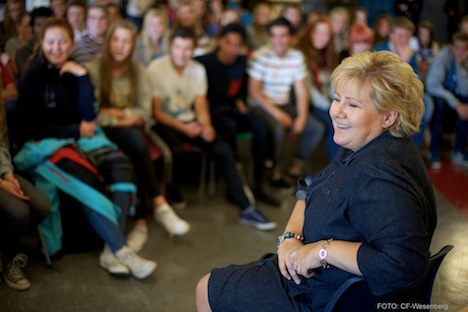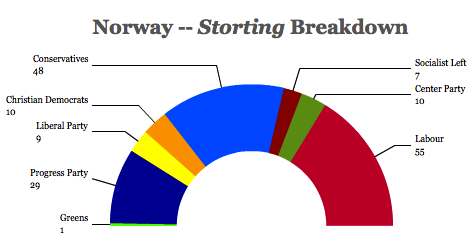Erna Solberg, the longtime leader of Norway’s Conservative Party, will become Norway’s next prime minister after results from today’s Norwegian parliamentary election showed all four of Norway’s center-right parties winning enough seats to form an absolute majority in Norway’s Storting (parliament).![]()
Prime minister Jen Stoltenberg has conceded defeat, and will resign shortly after presenting Norway’s next budget in mid-October.
The result’s a lot more complicated than that — for starters, Stoltenberg’s party, the center-left Arbeiderpartiet (Labour Party) actually won more votes than Solberg’s party, the center-right Høyre (literally the ‘Right’) — so much so that Labour will have around 55 seats to just 48 for the Conservatives. It’s not an unexpected result because while polls earlier this summer showed the Conservatives leading Labour, support for Labour has increased as Norwegians focused on the campaign. Moreover, Labour has emerged in every election since 1924 with more support and seats than Norway’s various opposition parties, and its long pedigree as the natural party of government means that it has a deeper wellspring of support among the Norwegian electorate.
Here’s the breakdown of voter support with nearly all the votes counted:
Here’s the projected allocation of seat in Norway’s new parliament:
But that wasn’t enough to pull off a victory for two reasons. First, Labour’s support — around 30.9% — is smaller than the 35.4% it won in the September 2009 election, natural enough for a party that’s been in power for eight years and is seeking a third consecutive term. Secondly, the two small parties that comprise the ‘red-green’ coalition that Stoltenberg heads, Sosialistisk Venstreparti (Socialist Left Party) and the Senterpartiet (Centre Party), did incredibly poorly, so the ‘red-green’ coalition is projected to win just a cumulative 72 seats in the 169-member Storting.
Meanwhile, Solberg’s Conservatives cannot govern by themselves, but must form an alliance among the four major center-right parties that will join parliament. That includes the Kristelig Folkeparti (Christian Democratic Party), a moderately conservative party that led Norway’s last center-right government under prime minister Kjell Magne Bondevik between 1997 and 2000 and again from 2001 to 2005, and it includes Venstre (literally, ‘the Left,’ but commonly known as the Liberal Party). All three parties worked together in government between 2001 and 2005 and all three parties generally accept the fait accompli of the Norwegian social welfare state and Labour’s rules to stash much of Norway’s annual budget surplus in the country’s massive oil wealth fund. The Conservatives, in particular, have spent the election arguing for slight changes to the status quo, such as lower business taxes and tweaks to Norway’s health care system, after a major rebranding exercise to grow beyond their base of Oslo business interests.
But the coalition must also include the more controversial Framskrittspartiet (Progress Party). Most reports highlight that the party is relatively populist and anti-immigrant, and that it was the party of Norway’s Anders Behring Breivik, who was responsible for the deadliest killings in Norway’s history in twin attacks in 2011. That’s all true, but the party’s roots are in the anti-tax movement of the 1970s, and its goal is a massive rupture from the status quo — it would claw back many of Norway’s social benefits, drastically reduce the role of government in Norwegian life, but it would also push to spend more of the Norwegian oil surplus (or return it in the form of lower taxes). Continue reading Solberg set to lead broad center-right coalition in Norway after today’s election



